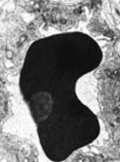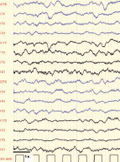The eLitMed.hu medical portal uses computer cookies for convenient operation. Detailed information can be found in the Cookie-policy.
Clinical Neuroscience - 2011;64(03-04)
Content
[Epilepsy in the elderly]
[The incidence of epilepsy is higher among the elderly, the most rapidly growing segment of the population, than in any other age group. New-onset seizures in elderly patients are typically symptomatic or cryptogenic partial seizures that require long-term treatment. Epilepsy in the elderly is a frequently occuring pathology, differing in etiology, clinical presentation and prognosis from those of young people. Establishing the diagnosis of epilepsy in old age can be more difficult than in younger patients due to the extensive range of differential diagnoses and a higher prevalence of concomitant disease. Beyond a certain age physiological and pathophysiological changes can affect the pharmacokinetics and pharmacodynamics of antiepileptic drugs(AEDs), increasing the risk of pharmacological interactions due to polypharmacy. Furthermore, the elderly people are sensitive to advers events of AEDs, as for example, to cognitive disturbances, osteoporosis. Several of newer AEDs have good safety and cognitive effect profiles and have no interactions with other drugs. The treatment strategies are demanding: they must take into consideration the co-morbidity, co-medication, alterations in drug metabolism, and the effects on aging body. These factors make the management of epilepsy in the elderly particulary challenging, but with appropiate pharmacological treatment most elderly people with epilepsy will remain seizurefree.]
[CADASIL and other hereditary small vessel diseases of the brain - Increasingly diagnosed conditions underlying familial ischaemic stroke and dementia]
[CADASIL (Cerebral Autosomal Dominant Arteriopathy with Subcortical Infarcts and Leukoencephalopathy) has recently gained great interest in vascular neurology as the most common heritable cause of stroke and vascular dementia in adults. This autosomal dominant small vessel disease of the brain - unlike the sporadic, hypertensive form - appears already in adult midlife in the absence of vascular risk factors with ischemic episodes and progressive dementia, its first manifestation can be migraine with aura, and is often associated with psychiatric disturbances. The magnetic resonance imaging (MRI) changes showing a characteristic pattern may precede symptoms by more than a decade. The identification of the mautation of the NOTCH 3 gene responsible for the disorder encoding a transmembrane receptor of vascular smooth muscle cells - has given great impetus on research to understand the molecular and vascular pathogenesis of the disease. The special importance of this latter lies in the fact that CADASIL provides a pure genetic model for subcortical cerebral ischemia and vascular dementia without the confounding factors of comorbidities and advanced age. Thus insights into CADASIL may help us better understand the more common sporadic forms as well. Moreover CADASIL is one of the best studied examples of secondary migraine. Currently we have far less knowledge on other forms of hereditary small vessel disease of the brain such as CARASIL, HERNS, CRV, HVR, PXE etc. Neurologists are becoming more and more familiar with CADASIL, and with the wider availability of MRI it is increasingly diagnosed. However the disorder is still probably underrecognised. This review aims to summarize our current knowledge on CADASIL with special emphasis on diagnostic and diffrential diagnostic points for the practising neurologist.]
[Interdisciplinary approach of vestibular system impairment]
[In the first part of this review the definition of vertigo/dizziness was discussed. The major difference between the two signs is the exsistence of the direction, which is specific for vertigo. Dizziness is a frequent complaint in the clinical practice. Its frequency is increasing with advance of age, to intimate the play of declining cognitive process in the pathogenesis of its. The popular health significance of vertigo is in the rowing number of the patients. The onset of the most cases with acute vertigo appears between secundums and minutes so the patients will be provided in circumstances of emergency department. First of all three form schould be take into account: neuronitis vestibularis, benign paroxysmal positional vertigo and Meniere syndrome. Without tipical periferal signs of vertigo, central cause should be searched, principally stroke (lysis possibility). The differential diagnose of the different dizzeness/vertigo forms according to the elapsed time of the onset or congenital and acquired nystagmus was created in tables. The recommendations of the therapy of acute and chronic dizziness/ vertigo syndroms are, lack of results of evidence based trials doubtful. The more often used drugs based on clinical trials are discussed as vinpocetine, betahistine and piracetam. The in vitro and in vivo data suggest that the last molecule is eligible to use both in periferal and central type of vertigo syndroms.]
[EEG source localization using LORETA (Low Resolution Electromagnetic Tomography)]
[Electroencephalography (EEG) has excellent temporal resolution, but the spatial resolution is poor. Different source localization methods exist to solve the so-called inverse problem, thus increasing the accuracy of spatial localization. This paper provides an overview of the history of source localization and the main categories of techniques are discussed. LORETA (Low Resolution Electromagnetic Tomography) is introduced in details: technical informations are discussed and localization properties of LORETA method are compared to other inverse solutions. Validation of the method with different imaging techniques is also discussed. This paper reviews several publications using LORETA both in healthy persons and persons with different neurological and psychiatric diseases. Finally future possible applications are discussed.]
[Anti-NMDA-receptor encephalitis: description of the syndrome in line with presentation of the first Hungarian patient]
[In the majority of cases, anti-NMDA (N-methyl-D-aspartate) receptor encephalitis is a severe, but treatable disorder, therefore early diagnosis and adequate therapy are very important. It should be suspected in children and young women, who develop acute psychiatric symptoms and seizures. During the course of the disease severe encephalopathy, agitation, hallucinations, orofacial dyskinesias, prolonged cognitive disturbance, autonomic symptoms can be observed and akinetic mutism develops. EEG shows diffuse slowing. Brain MRI is normal or unspecific. Elevated protein, pleiocytosis and oligoclonal bands can be present in the CSF. Detection of NMDA-receptor antibodies in sera or CSF confirms diagnosis. We present the case of a 15-year old girl, who fully recovered within two months after steroid treatment and repeated plasma exchange. Ovarian teratoma has not been detected.]
[Account on the celebration of Dr. Schaffer Károly Prize]
[Account on the celebration of Dr. Schaffer Károly Prize 2011;64(03-04)]
[About the future of neurology - answer to Csaba Ertsey]
[About the future of neurology - answer to Csaba Ertsey 2011;64(03-04)]
1.
Clinical Neuroscience
[Headache registry in Szeged: Experiences regarding to migraine patients]2.
Clinical Neuroscience
[The new target population of stroke awareness campaign: Kindergarten students ]3.
Clinical Neuroscience
Is there any difference in mortality rates of atrial fibrillation detected before or after ischemic stroke?4.
Clinical Neuroscience
Factors influencing the level of stigma in Parkinson’s disease in western Turkey5.
Clinical Neuroscience
[The effects of demographic and clinical factors on the severity of poststroke aphasia]1.
2.
Clinical Oncology
[Pancreatic cancer: ESMO Clinical Practice Guideline for diagnosis, treatment and follow-up]3.
Clinical Oncology
[Pharmacovigilance landscape – Lessons from the past and opportunities for future]4.
5.












